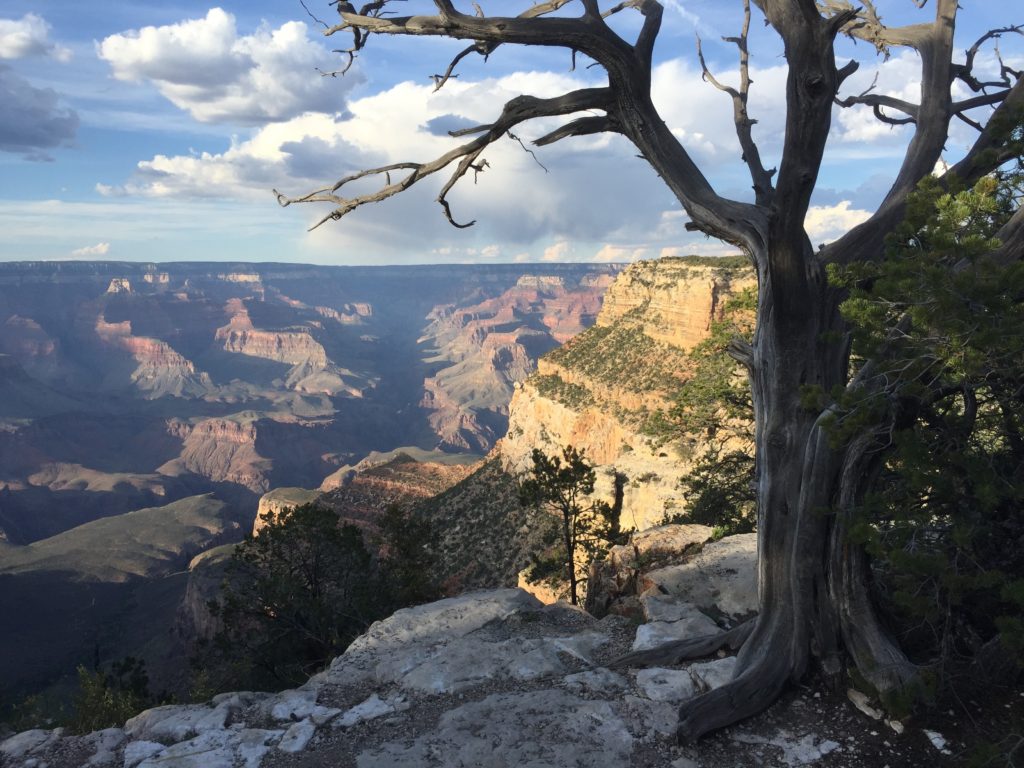
What is precious, is never to forget
The essential delight of the blood drawn from ageless springs
Breaking through rocks in worlds before our earth.
-Stephen Spender
God scratched at the earth and with a cosmic fingernail and gave us the Grand Canyon. Blinking in near disbelief at the sight of it, I have the same reaction as millions before me who scanned it from the precipice: a moment of stupefication and silence.
How did I get to be 64 years old and not have seen the Grand Canyon, I asked myself. Well here I am–we are. And in two days Robin and I would be joining the one percent of annual visitors who venture all the way to the bottom, where the Colorado River continually gouges the canyon deeper.
We were part of a group of 16 people assembled by my neighbor Mitchell. Some of us, including Mitchell and his wife Rhonda, form a dinner group that’s been getting together for nearly 25 years. Others were what we jokingly call Mitchell’s hiking wives — four women he’d met and befriended on his nine earlier Grand Canyon hikes. Still others were simply long-time, out-of-town friends of Mitchell and Rhonda. For Mitchell the trip was partly reunion with the “wives” and partly a way to engage friends in an endeavor about which he is both passionate and expert. Plus, the trip roughly coincided with his 60th birthday.
Somehow Mitchell — experienced in the mysteries of the National Park Service — managed to get us all reservations at the fabled Phantom Ranch, a sort of rustic Shangri La at the bottom of the Canyon for which the National Park Service has an eternal waiting list. We knew we’d be going a year in advance. Mitchell had gently pushed the local friends, including us, into a series of training hikes. One on occasion, we’d marched up and down relatively small Sugarloaf Mountain — a pimple compared to the Western geological structures — three times in one morning.
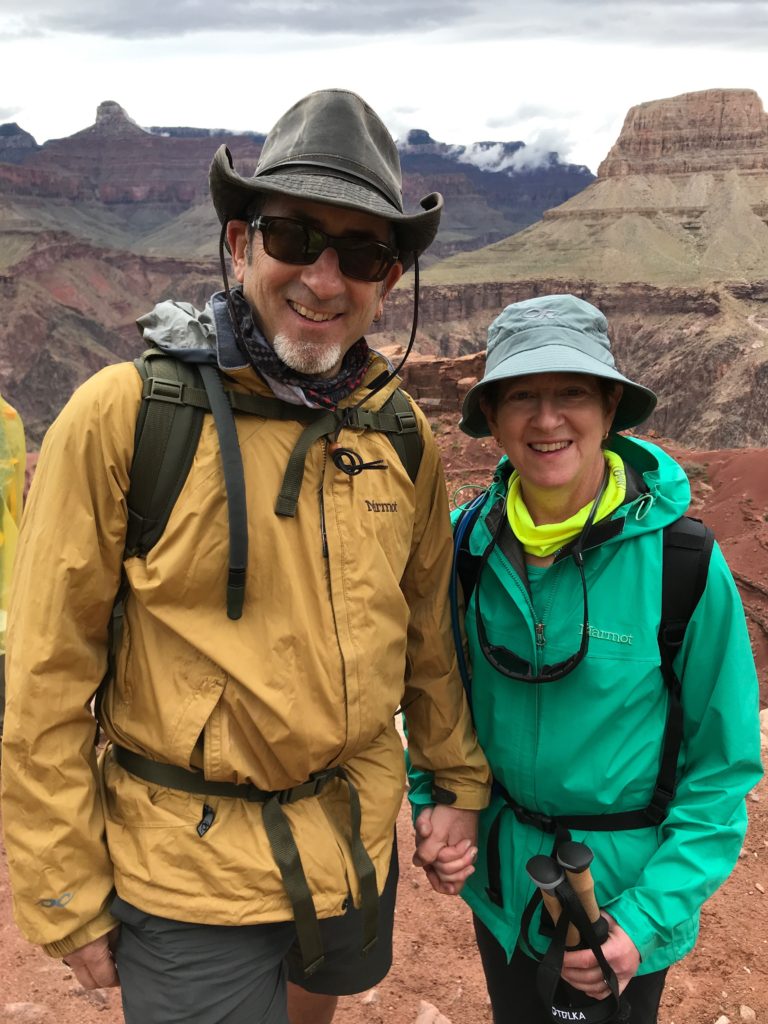
Robin and I depart BWI on a chilly, rainy day in late April. After a night in the airport hotel, we head to Grand Canyon National Park. (On the way Robin indulged me in a visit to Grand Canyon Harley-Davidson so I could get a souvenir T-shirt). At the gates to the park, I realize I’d forgotten my senior pass, but the ranger admits us for $20 and issues a one-year pass.
After arrival and check-in, the “Mitchell group” meets at a private dinner Rhonda had arranged — a buffet of tacos, burritos and rich apple pie — at the Thunderbird Lodge, one of the motels in the Park Service village on the South Rim of the Canyon. The mixed group hits it off, and we would enjoy one another’s company all the way down and back up.
The main anxiety most of us had was: we’d be sharing bunks and dorm-type lodgings at Phantom Ranch. One dinner group guy, Kal, worried his snoring would keep the whole cabin awake. I worried how I’d dive into bed while avoiding the women seeing me in skivvies.
The next morning, and the day before the descent, we pedal rented bicycles along the rim road, stopping frequently for pictures and to take in the scenery. Vast as the Canyon is, the views change every few feet, and they’re hard to turn your eyes away from. Ansel Adams, the photographer, commented that light is a substance. Light is a component of the Canyon’s grandeur, the way its distances and colorful, rocky formations mix with the special quality of light in the Southwest.
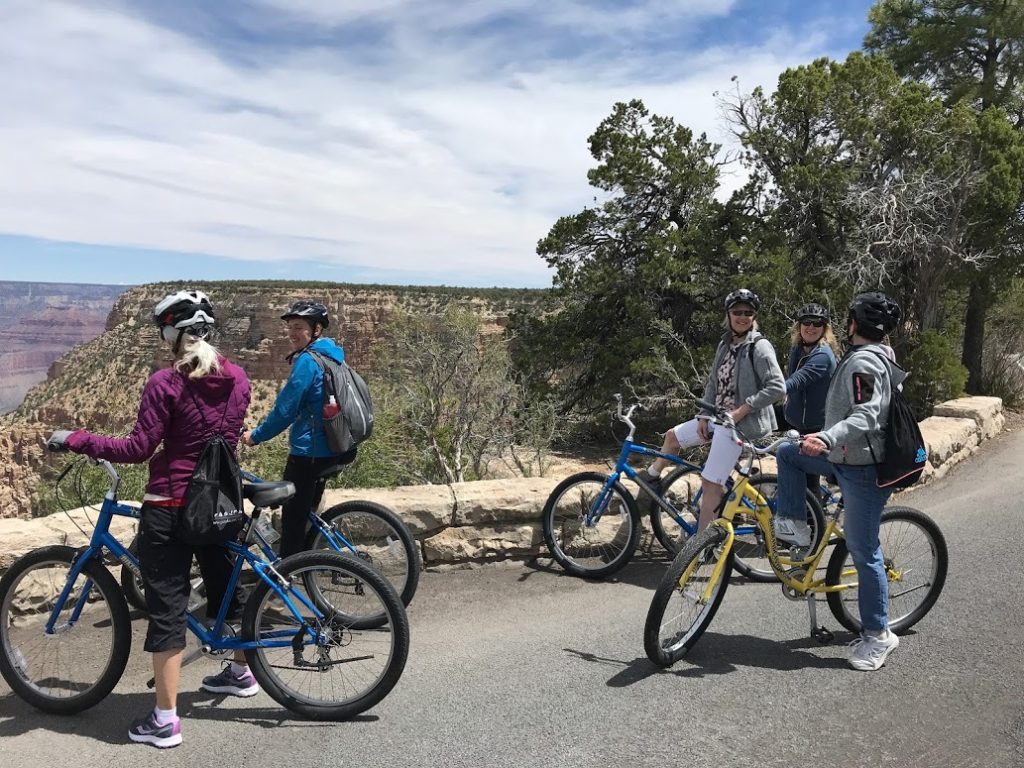
After that we explore the Grand Canyon Village, full of a mixture of tourists alighting from buses and skinny, serious hikers and backpackers. A deer-like critter — actually a Grand Canyon elk — missing half its fur, wanders around, nibbling here and there and pooping where it pleases. It’s the object of a thousand cell phone pictures.
The next morning it’s time for the descent. Robin and I spend an hour fiddling with supplies and backpacks. With Mitchell’s coaching, we’d all filled our 3-liter water-bladder-equipped backpacks, and stuffed the remaining pockets with sandwiches, beef jerky, peanuts, pretzels, M&Ms, raisins, cookies, tuna packets, dried fruit, and, in my case, chewing gum. The night before we’d checked our duffel bags of clothes and supplies we’d need at the Phantom Ranch with staff. The bags were to head down via Park Service mules. Mitchell says to be prepared for the stuff to smell like mule. I worry my flask of whiskey will end up tasting like mule.
Finally we venture out of the Thunderbird and assemble for the 7 a.m. shuttle bus from the hotels to the head of the South Kaibab trail.
The morning has dawned with steady rain, wind and temperatures barely touching 50. Everyone is apprehensive. This could be a long day, walking some 9 miles and descending nearly 5,000 feet, all in lousy weather. A very tall man with his 11-year-old son, Bear, is on the bus. They, too, are headed to the bottom and Phantom Ranch. Bear clutched a stuffed animal, a fish called Seaweed. I thought, if he can make it down and back, so can I. We’d cross paths with Bear and dad numerous times over the next three days.
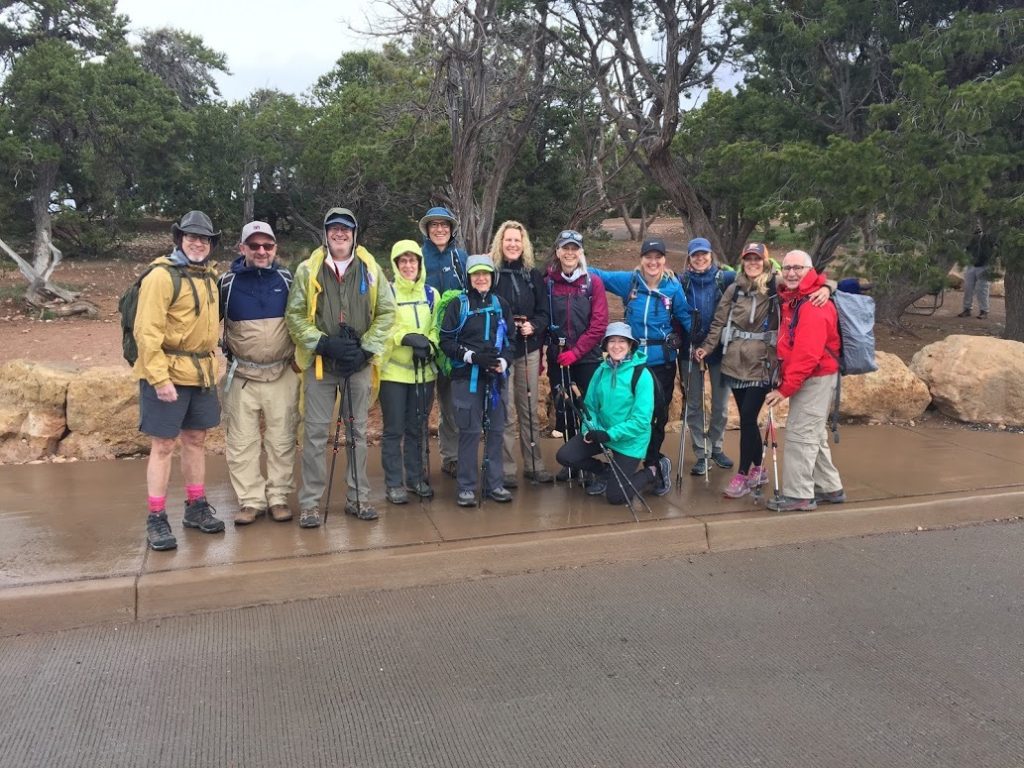
Miraculously, the rain lets up as we alight at the trailhead. The sky brightens. Our moods lift. After final words of encouragement and instructions from Mitchell, off we march.
Soon the trail descends and the rim disappears from view. The deeper in the Canyon you get, the more spectacular the views. The sky is alternately sunny and cloudy, adding an ever-changing wash of light. The rock cliffs form canvases of an astonishing array of subtle colors. Sometimes an angular chunk of stone tumbles down, reminding you that the Canyon is a living, changing thing. Cactuses, ferns, agave plants, and little flowering shrubs sprout from every crevice.
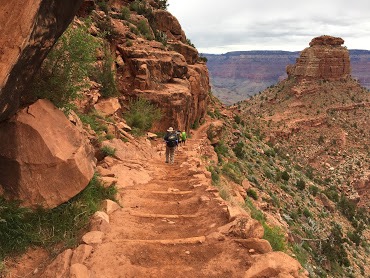
Sometimes you’re stepping — in my case with excessive deliberation, since I’m afraid of heights — along narrow, rocky paths with a wall of stone on one side and a seemingly bottomless abyss on the other. At other times you’re striding across upland meadows or desert-like plains dotted with plants. The plants array themselves on the weedless, crushed rock flats almost as if a cosmic gardener arranged them.
At one point I’d walked quite a few paces ahead of the group, caught up in my own stride and my own thoughts. I notice I’m not within sight of anyone. I feel alone in the majesty of the Canyon. That’s when the sky, threatening all morning, breaks into an energetic thunderstorm. The rain comes down pretty hard. Lightning streaks overhead, with peals of thunder reverberating for 30 seconds among the Canyon’s formations. Yet in the distance sunbeams penetrate holes in the clouds.
I think of the patriarch Jacob, who exclaimed, “Surely God is in this place and I hardly knew it.”
I arrive at a pit stop, where we were to regroup. It consists of a tiny, two story wooden building. Steps lead to a covered balcony and a set of doors, each containing a mulching toilet. Several hikers huddle under the balcony waiting for the the rain to pass. They invite me to join them. They point to my right leg in shock.
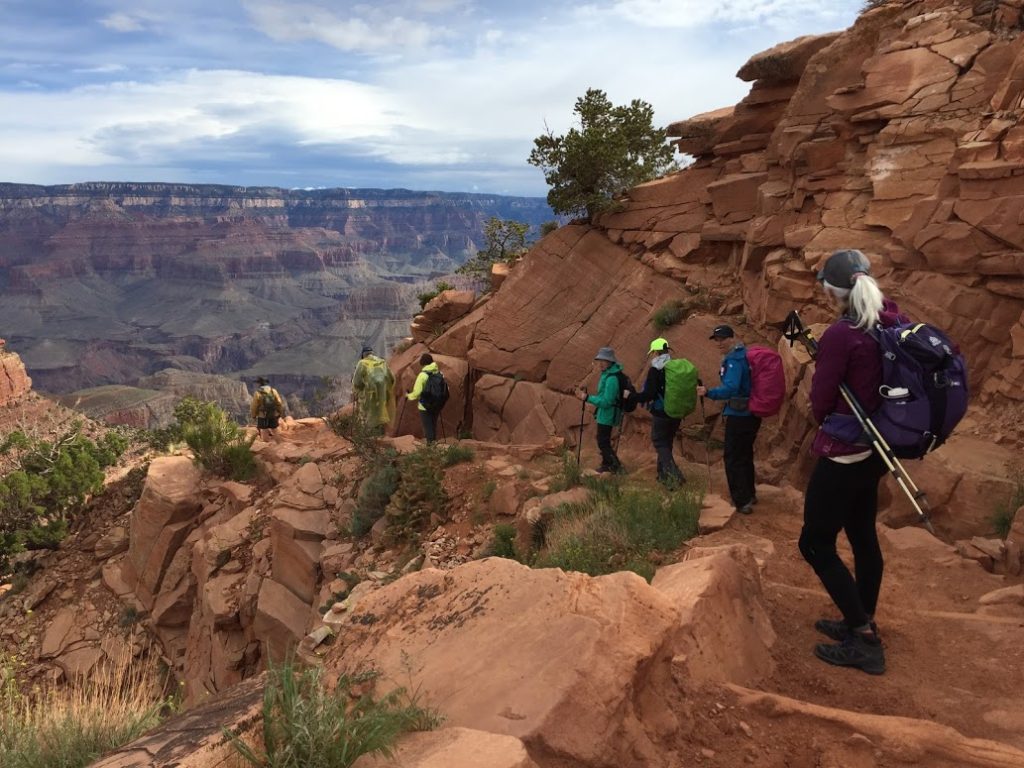
Right leg? Earlier, stepping off the trail to let a mule train pass, I’d scraped my shin on a rock. A member of our group, Karne (more about her later), had given me a disinfectant wipe to clean it off. But now the huddling hikers pointed out the site had ballooned into an egg-sized swell right next to my knee. It would bother me for the rest of the week.
Soon the others arrived and the rain passed. A man who’d sat down beside the trail a few minutes ago was the object of some commotion, visible from the rest site a couple of hundred yards back up the trail. He and his wife are with a guide. I’d passed them some time earlier. Their guide comes down to confers with some of our group. Shortly after we resume hiking, a helicopter appears overhead. Later we learn the man had been fished out of the canyon, for some reason unable to go on.
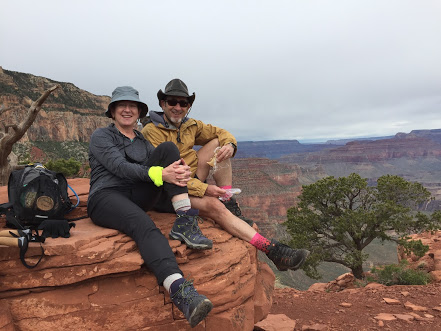
On we trudge for hours, stopping at one magnificent lookout after another. It’s tiring but also exhilarating. I feel almost as if I’m exploring the moon, so extraordinary and relatively deserted is the passing architecture.
By and by we arrive at the edge of the inner canyon, a canyon within a canyon. From the rim it looks like a bottomless slot. Close up we see it’s the channel through which the Colorado River flows, flanked by what looked like 1,000-foot rock walls. From the now steep and zig-zagging trail a bridge across the river came into view way down below, signifying the final leg before reaching the bottom, near Phantom Ranch.
In reality it takes us another hour to descend to the bridge. The bridge is preceded by a long, dark tunnel through the rock anchoring it. Emerging onto the bridge, you’re still 50 or 60 feet above the rapidly rushing river. The blue-green river looks unforgiving. I shudder at the thought of slipping off the bridge (which has hefty railings).
After a half hour of thankfully flat hiking, we stop by a sandy outcropping at the river, like a little beach. It’s called Boat Beach. We take off shoes and socks and wade in. The water is so cold I can only stand it for 30 seconds.
After admiring the Colorado River for a little while, we hike another quarter hour and arrive at the Phantom Ranch, a homely collection of low, stone and wood structures built in 1923. We arrive during a four-hour window in which the staff prepares and serves dinner. We decamp into our cabin, which houses five sets of bunk beds. Robin insists I take the lower bed of our bunk, because of my increasingly achy bruise.
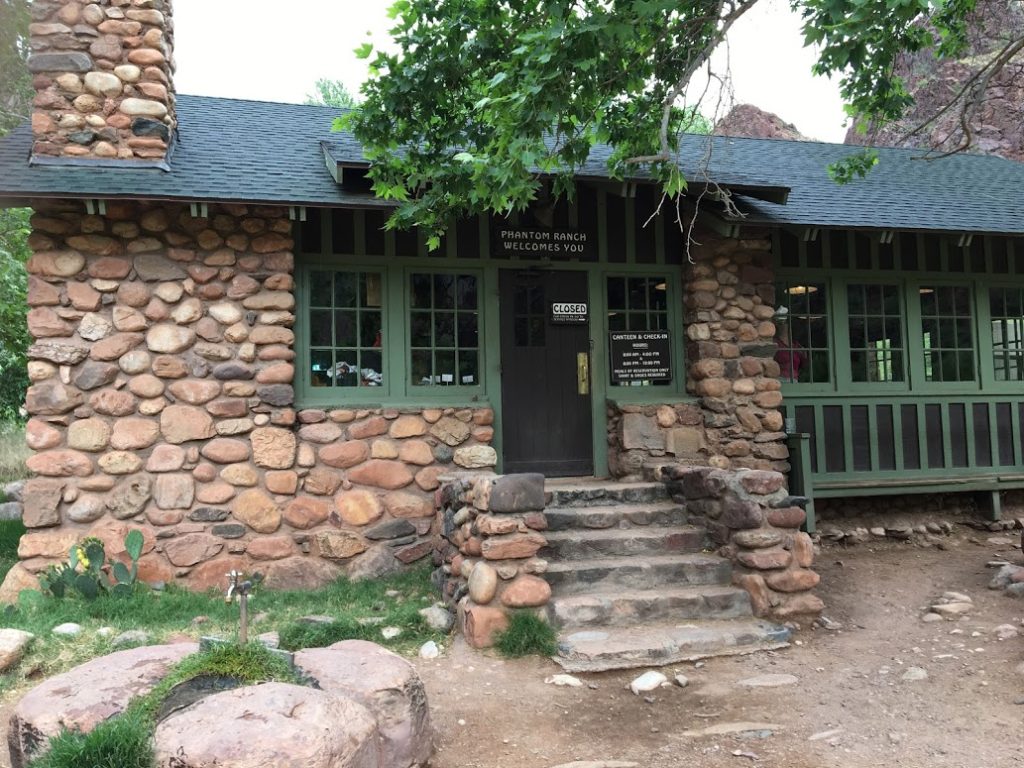
The bunk includes a sink and a cramped water closet. Mitchell tells us he’s been informed that because of low water pressure, it’s necessary to bring a bucket of water, kindly supplied by the Ranch, and spill it into the toilet to produce a flush. I resolve to use the pit toilets 100 yards down the path.
Everyone chuckles at how cramped and dimly lit the bunkhouse is. It has a stone floor stretching into dark corners, but the floor appears to have been swept. Sheets and towels were fresh.
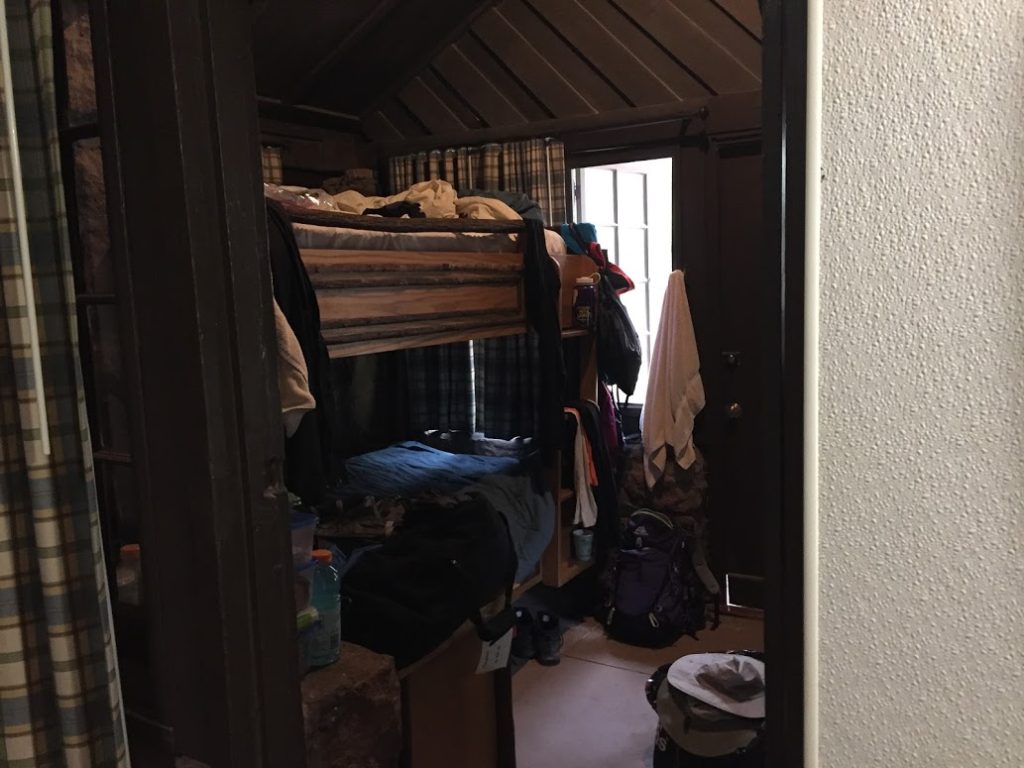
As we bustle about, Mitchell advises us to keep the door shut, lest squirrels scamper in and chew into our backpacks seeking food. We retrieve our duffel bags from the mule station. But the bunk house, no hotel, lacks any real storage space so we juggle. The calico-colored Canyon squirrels have a notorious reputation for aggressiveness. A sign warns you not to feed them, with a photo of a hand with a vicious chunk bitten out of it.
Beds, backpacks and duffels more or less squared away, I venture to the shower house to wash away the rigors of the 7-hour hike. It is quiet and relatively clean and roomy, with a decent shower head. Phantom Ranch provides towels. Now in fresh clothes, I settle onto a bench in front of the bunkhouse. My flask of Jack Daniels had arrived, unharmed by the mule, and I take a few pulls from it, breathing in the spectacular scene from the bottom of the Canyon.
Soon a staff member rings an old fashioned dinner bell, signifying the second, 6:30 dinner seating. He checks off each name as we enter the rustic canteen. I notice a big and modern commercial kitchen in the rear. Staff had given me a bag of ice to put on my garish leg.
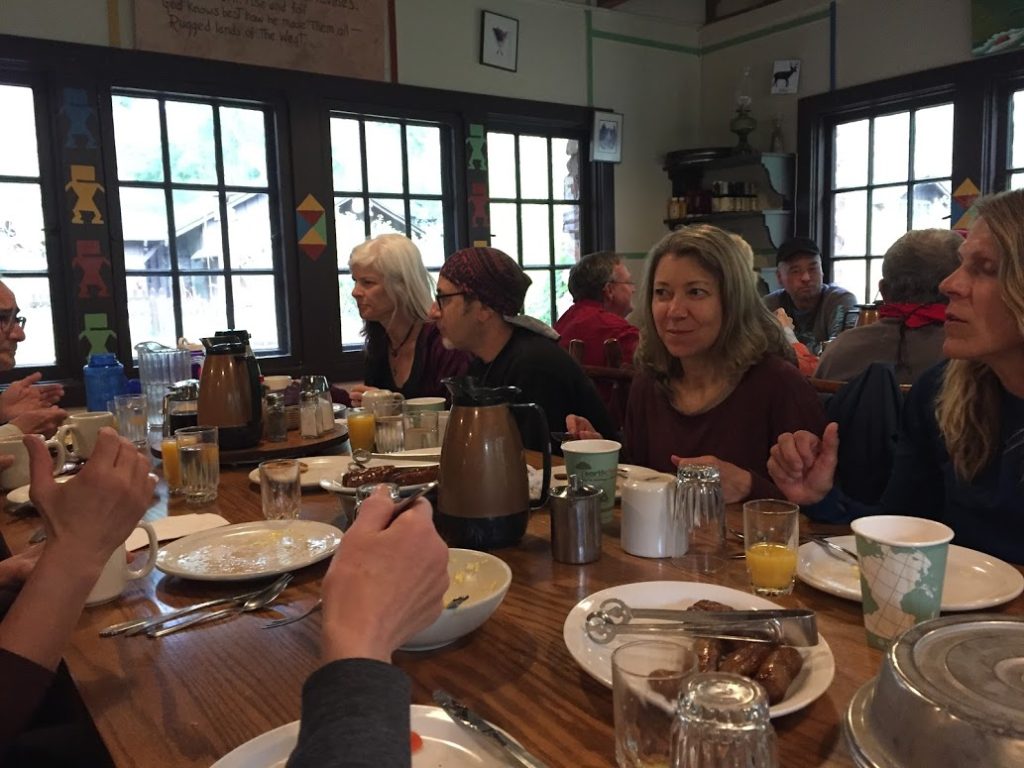
We tear into the traditional Phantom Ranch meal of beef stew or vegetarian chile, corn bread, fresh cut salad, and chocolate cake. An energetic man who looks about 60 feverishly serves the four long, family-style tables. Because we have a group of 13, we have a table to ourselves. The food is hearty, but there’s no lingering. The Ranch keeps a rigorous schedule. After dinner the server talks a little about the ranch and its history. A retired school teacher, he’d been working there for nearly a decade. Staff must hike in and out. They work 10 days straight, followed by four days off. I think, that’s certainly a way of life.
Everyone is shooed out so the canteen staff can close, clean up, and reopen at 8. People congregate in there until 10, drinking beer, playing cards, yakking. Then it closes for the evening. By 10:30 a deep silence envelops the Phantom Ranch. Aircraft flying overhead are too high to hear. The black sky is studded with way more stars than you can see at night in the city. I only wish the Canteen staff would shut off the fluorescent panel of the Lemmy’s Lemonade dispenser by a window. It casts an ersatz glow in the area near the building.
Next morning Mitchell wakes us all in time for everyone to get ready for breakfast. I do my business in the relative privacy of the pit toilets.
Breakfast at Phantom Ranch also occurs in two seatings. We take the later one — “later” meaning 6:30 a.m. Breakfast consists of big plates of scrambled eggs, glistening sausages, thick bacon fried to a crisp (the way I like it), pancakes, fruit salad (partially canned), and warm muffins. The coffee is good.
After breakfast, the aforementioned Karne — a “hiking wife” of Mitchell and a certified Grand Canyon guide who’s joined us just for fun — lays out an array on a picnic table. Tortilla wraps, cheese, salami, avocado, cucumber, veggie cream cheese and hummus. We form a line and one-by-one, Karne prepares scrumptious wraps for us to take on the day’s hikes.
Karne is a 50-something grandmother with the physique and taut, tanned skin of a 30-year-old athlete. She lives outside of Sedona, Arizona. Generous, open, talkative, quick to laugh, intelligent and skilled, she proves a fantastic complement to our organizer, Mitchell. She’d dressed my scrape and produced an ace bandage to hold it in. She was knowledgeable, giving expert mini-lectures on the geology and flora of the Canyon as we descended. Karne would prove instrumental to some members of our group in completing the hike back out.
Sandwiches packed, water bladders refilled from the outdoor spigot at the Ranch, it’s time for our day in the deepest recesses of the Canyon.
Part of our group hikes to the Colorado River, crossing two bridges and spending time at the sandy beach, meditating and wading in the cold water.
Robin, Jim and Kathy, Amy, and Diana and I take a scenic hike in the opposite direction, on a trail that runs along a narrow but furiously flowing Bright Angel Creek. Jim and Kathy are dinner group pals. Amy is Rhonda’s oldest friend, a lovable New York non-stop talker with whom I share a passion for running. Diana, still another friend Mitchell acquired hiking elsewhere, is a management consultant from California who share a nice quick pace with me.
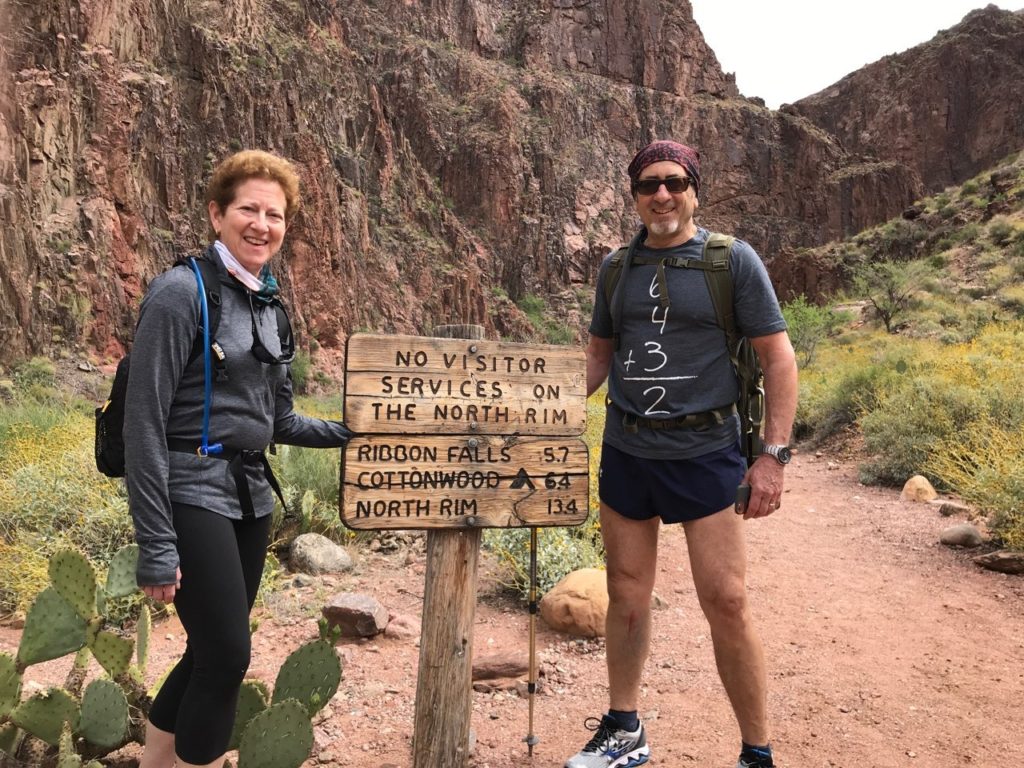
We can’t stop marveling at the ever-changing views of towering structures. We might still be at 2,000 feet above sea level, but we’re 6,000 feet below the North Rim and 5,000 feet below the South Rim of the Canyon.
Occasionally a lone hiker or small group would march through, en route to one of the rims. No flip-flopped, Dolce & Gabbana T-shirted dilettantes down here, only serious hikers, some with backpack loads worthy of a mule.
That afternoon everyone gathers back at the Phantom Ranch. Waiting for the canteen to open for the late dinner seating, we sit around the picnic tables and exchange stories from the day. Karne and I pass my flask back and forth, taking alternate pulls of whiskey.
Another dinner of stew, salad and corn bread. This night the cake is not chocolate but rather spiced with white icing. Tonight’s server informs us he is ending a one-year stint at the Ranch, soon to rejoin his wife in retirement. Odd. The wife has hiked down to accompany him out. Still later the canteen reopens after the dinner cleanup, and several of our group buy commemorative t-shirts. We spot the server’s wife cleaning the insides of the windows. I think, maybe she’ll be glad to have her husband rejoin her up in civilization, Phantom Ranch out of his system. Robin buys us each stretchy fabric tubes with the Phantom Ranch logo. I wear it as a sort of cool skull cap.
Anticipating, with a touch of apprehension, the climb out in the morning, the group turns in early. We do the kabuki ballet in the cramped bunk house. Again in the night I head to the edge of woods to pee rather than fiddle with the inside toilet. It’s a last chance to see the black sky and panoply of stars.
Another huge breakfast in the morning, then the scramble to repack our backpacks for the hike and our duffels for the mule transport. A worker at the mule tie-up tags and locks up our duffels, readying them for the next mule train departure.
The weather is cool but not windy and the sky is alternating sun and skittering clouds. It will take four of us eight hours to reach the South Rim, an hour and a half ahead of the rest of the group. We call ourselves TAKD — pronounced tack-dee. It stands for Tom, Amy, Kal and Diana.
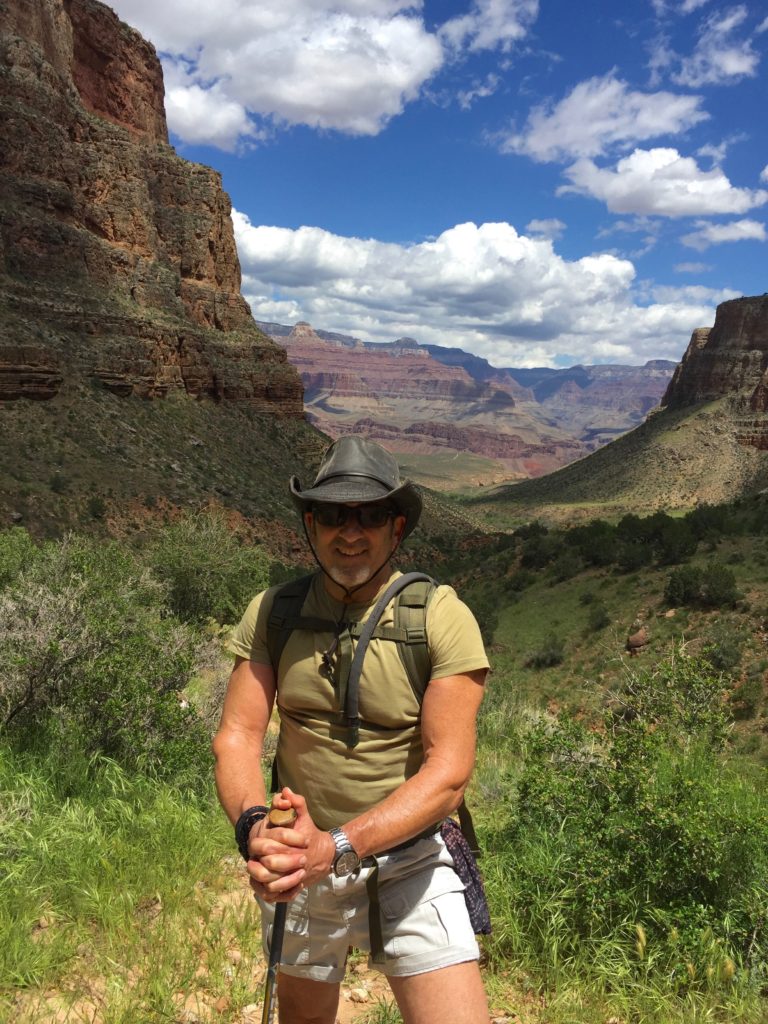
We’re ahead of the group before the first meeting point, a beautiful rest spot called Indian Garden. Bear and his dad end up there at the same time. Then our leader Mitchell grants the TAKD group leave to just go ahead at our own pace. That means I leave Robin behind but I know she’ll have lots of competent company. In truth it’s difficult to go below one’s own natural pace.
Not that the hike up is easy for TAKD. The Bright Angel trail we use is longer than the one down by a coupe of miles. For the first half, it rises and falls, ratcheting up gently. This won’t be so hard, I think. But a volunteer ranger tells us, when we stop and rest halfway, that the second half encompasses two thirds of the nearly 5,000 vertical feet.
And steep it gets, the meandering trail tilting into an endless series of steep switchbacks. The air is getting warmer and thinner. My t-shirt becomes soaked with sweat. We in TAKD take turns leading, but stopping with increasing frequency to catch breath, drink water and encourage one another. Amy’s chattiness proves a boon to our spirits. We’ve seen an endless, slow-motion unfolding of unimaginable beauty, but after five or six hours I’m ready to be back at the rim.
Gradually we start to see people hiking down with minimal gear, maybe a small backpack and a bottle of water. Some sport dainty flats. That is, people willing to walk down a mile or so then head back up. Like seagulls appearing to a ship long at sea, the casual strollers provide a sign we’re getting close to “shore.”
At 3 p.m., we’re there. The village comes into view along with all the tourists. Mitchell’s wife Rhonda and two other women who spent the three days at the rim, rush down a few yards to greet us. We’re all screaming and hugging with joy. I can’t hold back the tears. It’s the same feeling I used to get after completing a marathon — relief, pride, gratitude all roiling into an unstoppable wave of emotion.
Soon Mitchell phones Rhonda and says the rest of the group is making progress. A couple of people are slowing up, but they’ll be okay. Robin? I wonder. Still, the TAKD crowd does the official Mitchell way of celebrating our completion. We have gigantic Dryer’s ice cream cones from the Bright Angel Fountain at the rim. I choose Grand Canyon Chunk.
The air is turning chilly as afternoon comes on. I don a dry, long sleeve jersey as we await the arrival of the group. Mitchell texts Rhonda when they’re close. Soon they come into view down the trail. We in TAKD and the three women run back down to greet and embrace them. Robin and a couple others had flagged at one point. But Karne had helped them with water down the back and a lot of talky encouragement.
The full group, now back together, poses for a picture before a big stone sign.
The words “awesome” and “life-changing” are bandied so much nowadays as to have nearly lost meaning. But the Grand Canyon is awe-producing in the real meaning of that word. And having reached its mysterious depths and come back out in one piece, on the strength of your own two legs, does change your perspective. The trip also established new friendships and deepened old ones. And it reminded me of what a big nation with so much to explore we have right here in the U.S.
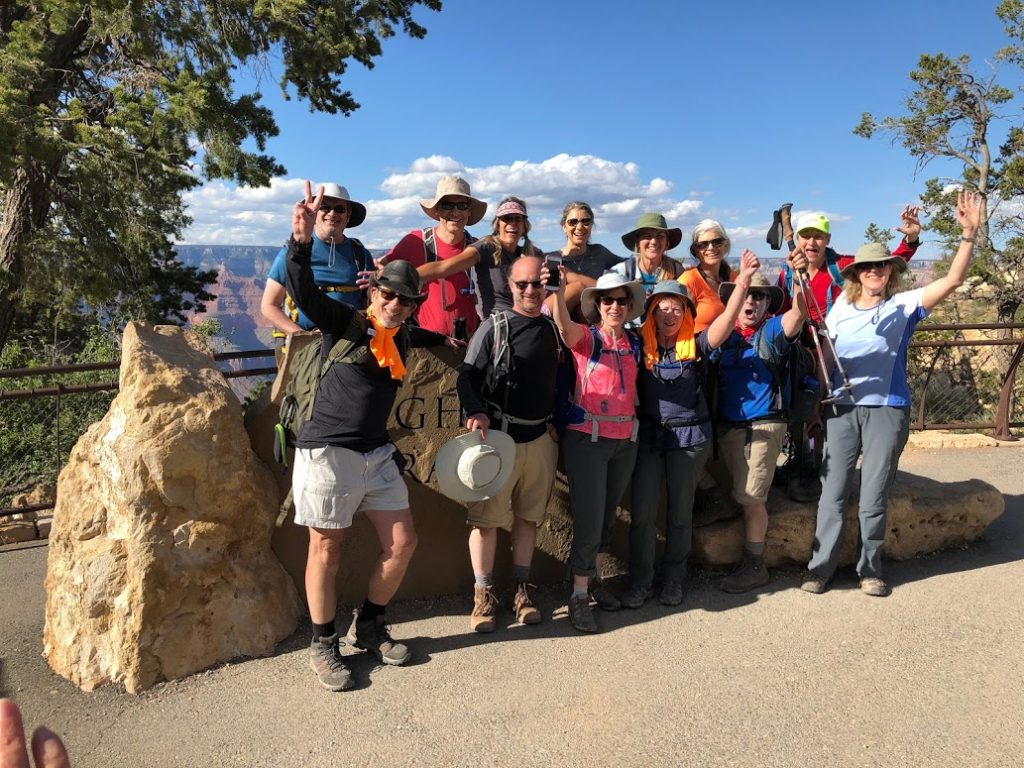
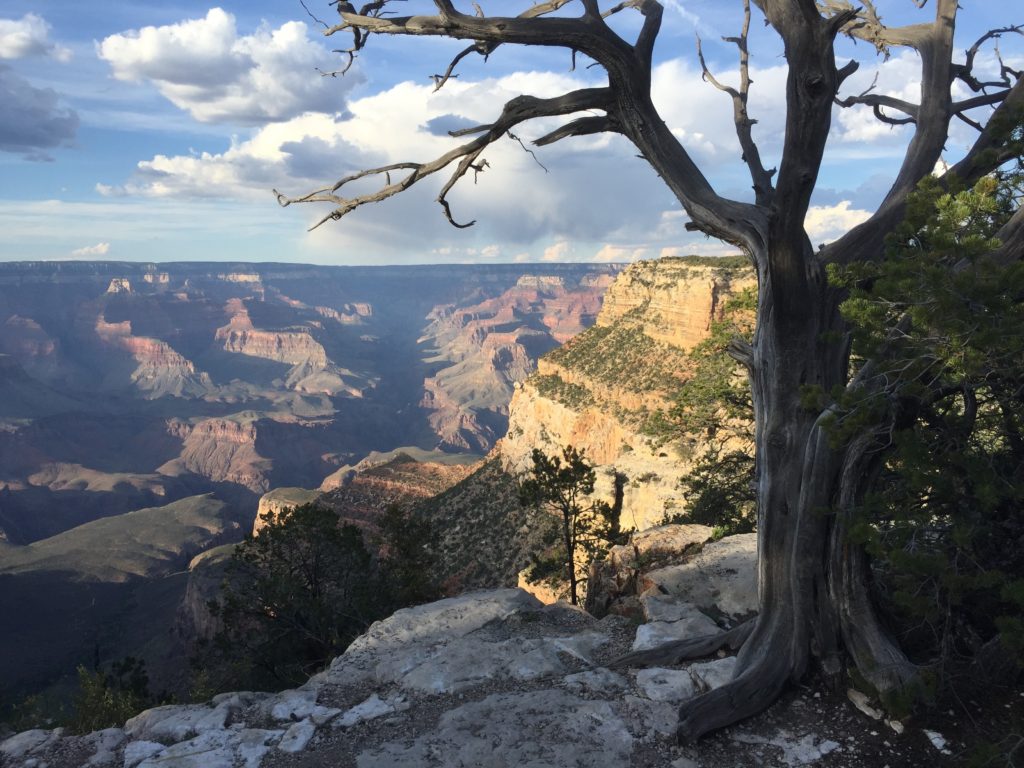
Comments are closed.